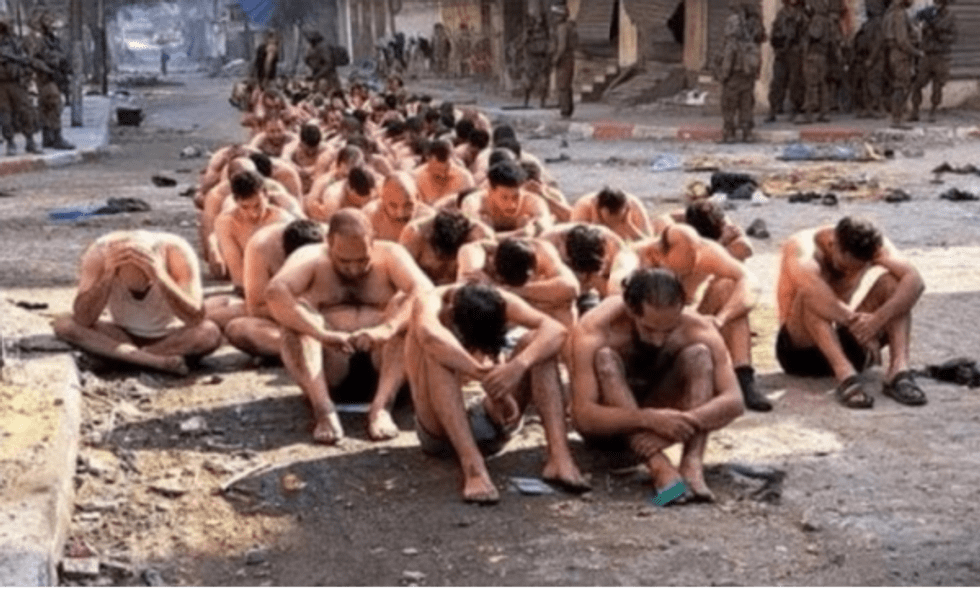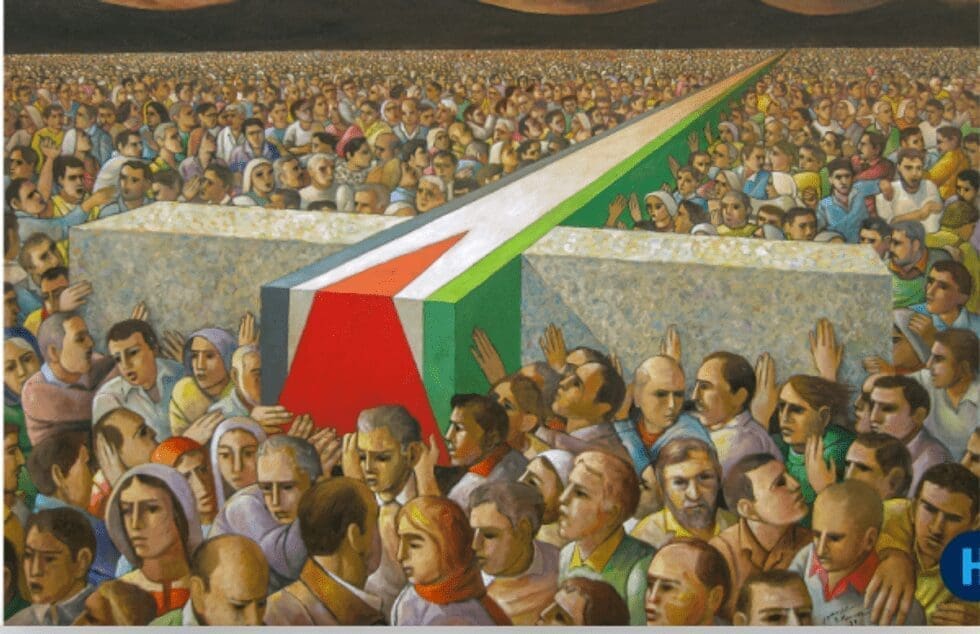Recently updated on August 6th, 2024 at 01:05 am
In a grim remembrance, the UN marked the 75th anniversary of the Universal Declaration of Human Rights by warning of a Gaza that “sinks further into the abyss”: “Those who do not die under the bombs are at risk of dying from hunger, thirst, and disease.” With the U.S. in awful lock-step, Israel has amped up its genocidal savagery, killing at least 9 innocents – children, academics, writers, none Hamas – for every possible terrorist. One weary, defiant Gazan: “They are trying to wipe out our memories.”
Meanwhile we, the world, watch in helpless grief and rage; even as we struggle with, have long grown weary of, confronting it, the victims haunt us. Honestly, it’s too much horror to incorporate in any number of accounts. “As journalists, words are our essential tools to report, explain, clarify and analyze,” writes Ha’aretz editor-in-chief Esther Solomon. “But the events (in) Israel and Gaza sometimes challenge the limits of language.” We’d change that to “often,” now more than ever. In the wake of the collapse of a too-brief ceasefire, the last week has seen the rolling catastrophe reach a sort of dreadful zenith both here and in Israel.
“The Israeli Army Has Dropped the Restraint in Gaza, and the Data Shows Unprecedented Killing,” runs a grisly Ha’aretz headline. The unfathomable death toll is now over 18,400, with perhaps 8,000 children; close to 8,000 more remain under the rubble; over 300 Palestinians in the West Bank have also been killed; also at least 86 journalists, 300 health workers and 100 UN aid workers, the most in their history. Tuesday, a visiting UNRWA official called Gaza “hell on earth” with up to 400 new deaths a day. Once again, for those swaddling the carnage in the trope of Israel’s right to defend itself: None of these people were Hamas fighters.
The numbers numb. Still, in a war of not just bloodied bodies but hearts, minds and propaganda machines, a recalcitrant Israel claimed a merciful, two-to-one ratio of civilian to militant deaths. In a ghastly computation, IDF spokesman Jonathan Conricus boasted that, “Compared to any other conflict in urban terrain between a military and terrorist organization, the ratio is tremendous, tremendously positive, and perhaps unique in the world.” Bull***t, retorted Euro-Mediterranean Human Rights Monitor and an appalled world.
Their data shows that 90% of Israel’s victims have been civilians, a rate worse than U.S. wars on Vietnam, Iraq, Afghanistan; the “pulverizing of Gaza ranks amongst the worst assaults on any civilian population in our time”; the destruction in Gaza over 8 weeks is comparable to that of the Allies’ years-long carpet-bombing of German cities Dresden, Hamburg and Cologne in World War Two; and it’s getting worse. Watchdog group Action on Armed Violence charges that Israel’s latest assaults have been four times deadlier than previously; they report the IDF hits up to 450 “targets” in 24 hours, or one every few minutes, with each strike killing an average of 10 civilians. One more time: None of the victims are Hamas.
Mother Jones: “Pray for the dead, fight like hell for the living.” With two million displaced to the south, aid workers are “hanging on by our fingertips” in hopes of mitigating “an untenable disaster.” Half to a third of people are “simply starving.” Civilians seeking shelter have become “human pinballs, ricocheting between ever-smaller slivers” of so-called safety and dead bodies.
With most hospitals closed, over 50,000 wounded cannot find treatment; hospitals still open often get more dead than injured; of over a million people in packed UN shelters, half have respiratory infections from the cold or rain, many have diarrhea from contaminated water, typhoid and cholera outbreaks threaten, 600 people share one toilet. Israeli forces bulldoze generators, bomb schools, storm hospitals, fire on ambulances trying to evacuate critical patients; blocked at checkpoints, paramedics are arrested as patients die waiting.
With the IDF “attacking anything that moves,” victims include those waiting in line for water and trying to evacuate while waving white flags. After an Israeli strike “like an atomic bomb” killed all 45 members, three generations, of one family in a house in az-Zawayda, neighbors worked for days to collect their body parts, “a hand here, a head there.” No Hamas among them.
Still, Israel charges implacably on. A new report reveals Netanyahu secretly asked his Minister of Strategic Affairs to design a plan to “thin” Gaza’s Palestinian population “to a minimum” through two means – persuade Egypt to facilitate refugees flowing to other Arab nations and open sea routes allowing “a mass escape to European and African countries.” His ethnic cleansing even suggests specific numbers: a million to Egypt, a half million to Turkey etc. In support for what many deem “a joint U.S.–Israeli war against the people of Gaza,” the U.S. has joined in, seeking over three billion dollars to fund refugees from Ukraine and Gaza and proposing aid conditions for Arab nations based on their willingness to take Gazan Palestinian refugees.
This week, that shameful “bear-hug” of complicity with Biden’s “great, great friend” Netanyahu has been on flagrant display: With the U.S. veto –its 2nd, and 45th time it’s refused to curb Israel – of a UN Security Council resolution for a ceasefire, its “emergency” shipment of more weaponry to Israel and debate on another $10 billion, its vapid “concern” about Israeli use of deadly white phosphorus in Lebanon, even an upcoming weekend of prayer planned by a Congressional Israel Allies Caucus to fire up lawmakers “for Zion’s sake.”
For now, Zion remains obsessively focused on revenge. Not satisfied with nearly 20,000 Palestinians dead, an infrastructure leveled, a population displaced, traumatized, starving, they seek humiliation – the kind they suffered on Oct. 7 when Hamas assailed their mighty military and intelligence machine, and found it lacking. Palestinians released from prison report a surge in abuse – torture, beatings, rape threats, broken bones for refusal to kiss the Israeli flag – and the deaths of at least six Palestinian prisoners.
The IDF has reportedly detained dozens of women and girls, with no information on their whereabouts. And disturbing photos in Beit Lahave shown about 100 men, including boys as young as 13, detained, taken from their homes and forced to sit in the street and cold in their underwear; others are shown packed into trucks. Israel called the action a “Hamas roundup.” Palestinians identified doctors, teachers, journalists, elderly shopkeepers who’d sought refuge in UNRWA schools, noted that not a single Hamas fighter has surrendered or been captured alive, and called it ritual humiliation with no military purpose. It was also extra-judicial execution: Euro-Med Monitor reported at least seven men were shot and killed when they refused to undress.

“The IDF is exterminating the Nazi Muslims in Gaza,” gloated Jerusalem’s Deputy Mayor Arieh King alongside a photo of the naked Palestinians, heads bowed, in the dirt. “If it were up to me, I would bring 4 D9’s (bulldozers), and give an order to bury (those) Nazis alive. They are not human beings.”
He added from Deuteronomy 25, 19: “When the Lord your God gives you rest from all the enemies in the land (you) possess..you shall blot out the name of Amalek from under heaven. Do not forget!” In another video, like-minded Israel soldiers fervidly dance and sing a genocidal song: “I have come to conquer Gaza/And hit Hezbollah on the head/And only adhere to one mitzvah/ To eradicate the seed of Amalek.” “This spirit is everywhere,” writes Jonathan Ofir, who once rejected the term “Judeo-Nazis” used by a late professor in the 1980s, as “a kind of moral exaggeration.” Now now: “The State of Israel represents the darkness of a state body.” This week’s protests echo him: a general strike in the West Bank, a global day of action, 18 Jewish “bubbies” – the 18 emblematic of “chai,” or life – chaining themselves to the White House fence. The “systematic effort to empty Gaza of its people,” warns Jordan’s Foreign Minister Ayman Safadi, “will haunt this region (and) define generations to come.”
In the end, what do we owe the victims? “Anything that is Palestinian, even just being here, breathing and thinking, is a sensitive matter to the Israelis, because they built their narrative around denying our existence,” says Palestinian painter Sliman Mansour, who for over 50 years has taught, exhibited, created galleries and documented his people in an “iconography of resistance,” painting through the destruction of his village, two Intifadas, two terms in prison, and Israeli officials seizing portraits of flowers because their colors replicated the banned Palestinian flag.

“Our work…is to express that we are here.” Many Gazans who survive remain intent on that task, on telling the stories of those who are gone – the children dead in the ICU from lack of oxygen, the 65-year-old father of an al-Jazeera reporter who refused to leave his home. “To those I’ve lost,” writes Sahar Qeshtaof Shymaa al-Jazaar, a friend from high school years, a photographer of kids, a “beacon of warmth, kindness and love,” and Sharouq al-Azoum, a lawyer and “source of hope to all who knew her.” “They are not defined by the tragedy of their deaths,” he writes. “These are people I have known and loved. They were people just like me and you.” .
In the unconscionable name of eliminating Gaza’s academic elites, Israel also killed Dr. Sufyan Tayeh, the president of the Islamic University of Gaza, an award-winning theoretical physicist ranked among the top 2% of researchers worldwide who served as UNESCO’s Chair in Physics, Astrophysics, and Space Sciences in Palestine. Dr. Tayeh was killed Dec. 2 in Jabalia alongside his father, wife, two sons, two daughters – several of them doctors – grandchildren, sister-in-law and her children.
Israeli forces also bombed the University’s medical school; gleefully celebrating their “Hanukkah gift,” soldiers scribbled in English the graffiti, “Ours Now.”
A few days later, in a loss deeply felt, they evidently, surgically targeted and killed beloved writer, mentor, father of five and “voice of Gaza” Dr. Refaat Alareer, a professor of English literature who co-founded We Are Not Numbers, empowering young Gazan writers to beshaheed, or witnesses and “tell our story”; most vitally, he nurtured hundreds of those young writers, “an army of writers and bloggers” who, today, you can widely read: “So Refaat is everywhere.” He was killed in an airstrike along with his brother, sister and four of her children, the only building in the al-Daraj area of Gaza City to be hit.
“Salam, Dr. Refaat,” wrote Wesam Thabet, a former student. “I hope you are in a better place now. You left before I was able to reply to your last message to me: ‘Do you need any help?’ Yes, we do need you…Your struggles have not been in vain.” “Your students are full of anger and sadness,” he wrote. Still, “We promise you we won’t drop the pen.” He ended with, “Rest in peace, my literature father.” Refaat’s first writing was about his brother Mohammed, “martyr number 26 in my extended family”; he went on to write widely, from poetry to political pieces; he also edited the anthology Gaza Writes Back and contributed to Haymarket’s Light in Gaza: Writings Born of Fire.
He was “steadfast in unimaginable ways,” wrote Asem al-Nabih, one of the last friends to see him alive. “If he lived, he wanted to be a storyteller, to tell the stories of Gaza and its people. “Every day, he and I would walk. We would go out (in) search of SIM cards or phone reception. You’d find him climbing on top of high walls, lifting his arm up to get reception,” he recalled. “We must remember that Refaat always walked and talked. He used to speak up. Now we’re saying, speak about him. Because Refaat deserves this.” “If I must die,” Refaat wrote in his last poem, “Let it be a tale.” He, too, wasn’t Hamas.
If I Must Die.
If I must die,
you must live
to tell my story
to sell my things
to buy a piece of cloth
and some strings,
(make it white with a long tail)
so that a child, somewhere in Gaza
while looking heaven in the eye
awaiting his dad who left in a blaze—
and bid no one farewell
not even to his flesh
not even to himself—
sees the kite, my kite you made, flying up
above
and thinks for a moment an angel is there
bringing back love
If I must die
let it bring hope
let it be a tale.








